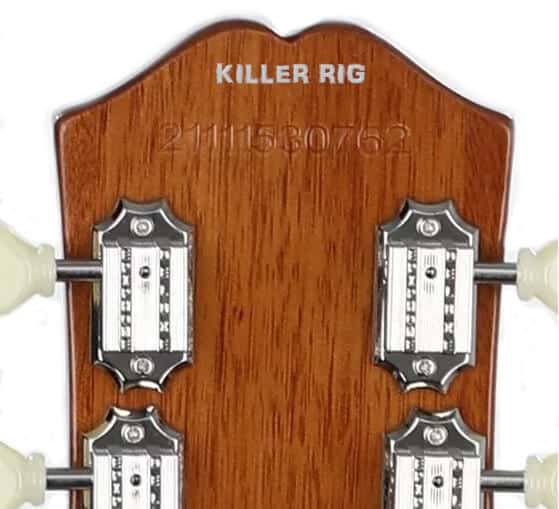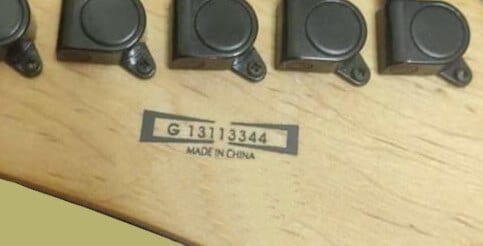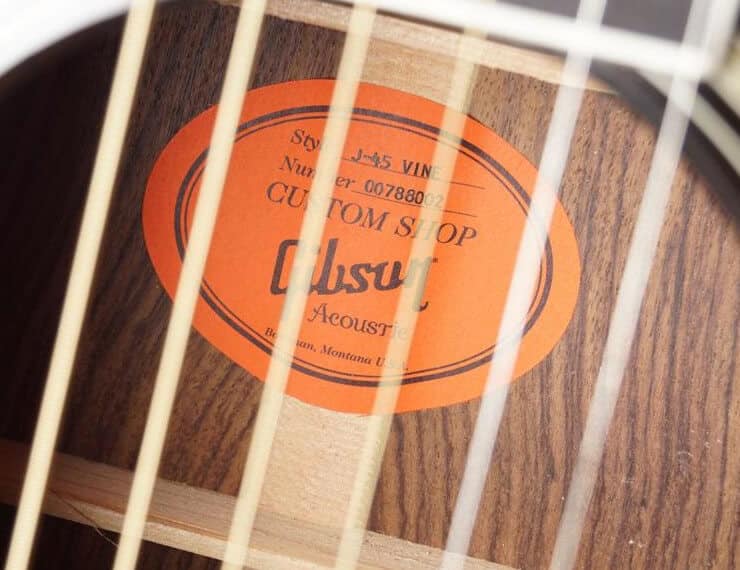Table of Contents
Guitar serial numbers hold paramount significance. These cryptic sequences, often ignored by the casual observer, represent a wealth of information about your instrument’s origin, age, and more.
Take an American-made Fender guitar, for example. Its serial number might read something like “MX12123456”. Here, “MX” signifies the country of manufacture, Mexico. The following two digits, “12”, mark the year the guitar was produced.
The remaining digits, “123456”, denote the unit number assigned during production. This is not a random selection of numbers and letters. It’s a concise history of the instrument.
These codes offer much more than simple trivia. They can be used to verify an instrument’s authenticity, estimate its value, identify correct parts for repair, and even trace a guitar’s production history.
This Killer Rig article aims to be a guide to guitar serial numbers. We’ll explore how to locate these numbers, how to decode them, and how to apply this knowledge in practical contexts.
Locating Guitar Serial Numbers
Understanding where to find the serial number on your guitar is the first step. Let’s explore where they’re commonly located.
Headstock
On many guitars, particularly electric models from builders like Fender and Gibson, the serial number is found on the back of the headstock. For some acoustic models and certain brands, it may be found on the top or even the front of the headstock.
Neck Plate
In some guitars, particularly certain models of Fender, the serial number may be stamped or engraved on the metal neck plate where it joins the body.
Soundhole or Inside Body
For many acoustic guitars, such as those made by Martin or Taylor, the serial number is often printed on the neck block inside the guitar body, visible through the soundhole.
Back of the Guitar
Some manufacturers opt to place the serial number on the back of the guitar body, often at the base where the neck meets the body.
Other Locations
Rarely, serial numbers may be found on the bridge, pickguard, or other components. These placements are less common and often specific to certain manufacturers or models.
If you’re struggling to find the serial number, visit the brand’s website or user manual. These often provide guidance on where to look.

Understanding Guitar Serial Numbers
The next step is to interpret the serial number once you have located it on your instrument.
Each component of a serial number, which often consists of a mixture of letters and digits, contributes to the narrative of the guitar. These codes can be interpreted as follows.
Brand Specific Serial Numbers
Each guitar manufacturer has its own system for serial numbers, and they can vary greatly. Some are straightforward, while others can be quite complex.
Fender Serial Numbers
Fender serial numbers typically start with letters that represent the country of manufacture. But this depends highly on the date it was made. Older guitars started with just a number. And sometimes even the letter denotes the decade.
This is followed by a few numbers indicating the year of production, and then the rest is a production number.
For example, in the serial number “US11223456”, “US” represents the United States, “11” denotes the year, and “223456” is the lot code.
Gibson Serial Numbers
Gibson’s system is a little more complicated. Their current system, used since 1977, generally includes an 8-digit number.
The first and fifth number represents the year of manufacture. The second through fourth numbers represent the day of the year. The remaining numbers are the production code.
For example, in the serial number “70108274”, “7” and “8” are the year 1978. “010” represents the 10th day of the year (January 10th), and “274” is the production number.
Special Characters in Serial Numbers
Some guitars may have special characters in their serial numbers, like “+” or “-“. These characters often have specific meanings, such as identifying a special edition or a certain batch of guitars. Always check the manufacturer’s guide for precise information.
Older Guitars and Inconsistent Serial Numbers
Serial numbers on older guitars or those from smaller manufacturers don’t always follow a pattern. Some were not even applied with a plan to keep records. In these cases, it can be helpful to consult specific resources or experts familiar with those brands.

Using Serial Numbers to Verify Authenticity
A fundamental reason to delve into the world of guitar serial numbers is to verify the authenticity of an instrument.
Given the unfortunate prevalence of counterfeit guitars in the market, understanding serial numbers can equip you with the tools to ensure you’re dealing with a genuine article.
Check Serial Number Consistency
Ensure the serial number aligns with the manufacturer’s numbering scheme. For example, if the guitar is purported to be a Gibson made in 1995, but the serial number format or embedded information doesn’t reflect this, it may be a counterfeit.
Cross-Reference with Official Databases
Some guitar manufacturers maintain databases of their serial numbers. Collect your serial number, then, enter it on the manufacturer’s website to retrieve information about the guitar. Fender is an example of a brand offering this service.
Inconsistencies in the Quality of Imprinting or Engraving
Counterfeit guitars may exhibit poor quality or inconsistencies in the imprinting or engraving of the serial number. This could be an uneven depth of engraving, misaligned characters, or any visible attempts to tamper with or alter the serial number.
Consult an Expert
If in doubt, consult an expert or a trusted guitar dealer. They can often verify a guitar’s authenticity based on their knowledge and experience.
Some experts can even tell you if your guitar is authentic just by looking at it, or some of the parts it has been equipped to use.
Using Serial Numbers to Understand a Guitar’s History
Serial numbers can often provide fascinating insights into your guitar’s history, including when and where it was made. While the specifics can vary by brand, the following steps can generally help you uncover the history of your guitar.
Identify the Place and Year of Manufacture
As we’ve learned, many serial numbers reveal where and when the guitar was made. Cross-referencing these details with historical data can provide context about the manufacturing environment at that time.
For example, some years might be known for exceptional quality control, while others might be infamous for certain manufacturing flaws. Similarly, some manufacturing locations are famed for their craftsmanship, which can add to a guitar’s allure.
Understand the Model and Series
A guitar’s model and series, which are frequently traceable to its serial number, can reveal a great deal about its past. It’s fascinating to observe how different models have changed over time, or how particular series have entered and exited production.
Trace the Ownership History
While this can be tricky and not always possible, in some cases, the serial number may help trace previous owners, especially if the guitar has been registered by its owners or if it’s ever stolen and reported.
Track the Guitar Through Time
You can sometimes use a serial number to follow a guitar’s history. This can be particularly relevant for:
- Collector’s items: These may have been part of a limited production run or a special edition series.
- Vintage guitars: Older guitars may have been produced during a particularly notable period in the manufacturer’s history.
- Used guitars: Especially if you’re buying a used guitar, the serial number can help verify the seller’s claims about the guitar’s history.
Remember that while serial numbers can provide a wealth of information, they may not reveal the entire history of a guitar.
Some details might only be known to previous owners or may have been lost to time. Nevertheless, every bit of information helps in appreciating the history of your instrument.

Using Serial Numbers for Guitar Registration
One important use of a guitar’s serial number is for registration. Registering your guitar with the manufacturer can provide several benefits, such as confirming authenticity, establishing ownership, and facilitating warranty services. Here’s how to do it:
Visit the Manufacturer’s Website
So, you’ve got your special serial number. Now, it’s time to visit the official website of your guitar’s manufacturer. Look for the product registration page. Most major brands, like Fender, Gibson, and Ibanez, provide online registration services.
Enter the Necessary Information
Typically, they’re going to need stuff like your guitar’s model and serial number, and also the date when you bought it. And they might ask for some info about you, too. Why? Well, not only does it help the whole sign-up thing go without a hitch, but it might also come in handy down the line.
Save the Registration Confirmation
You need to get a confirmation after successfully registering your guitar, often via email. Don’t forget to store this for later use.
Registering your guitar using its serial number is an easy process. You might feel more at ease as a result. It not only establishes your ownership, but can also be quite beneficial in the event that your instrument needs service under warranty or is stolen.
Conclusion
The serial number on a guitar is much more than a mere collection of letters and numbers. As we have explored, these codes offer valuable insights about the instrument, such as where and when it was made, its model, and sometimes even special features or modifications. Do some research and see what it might uncover about your guitar!

